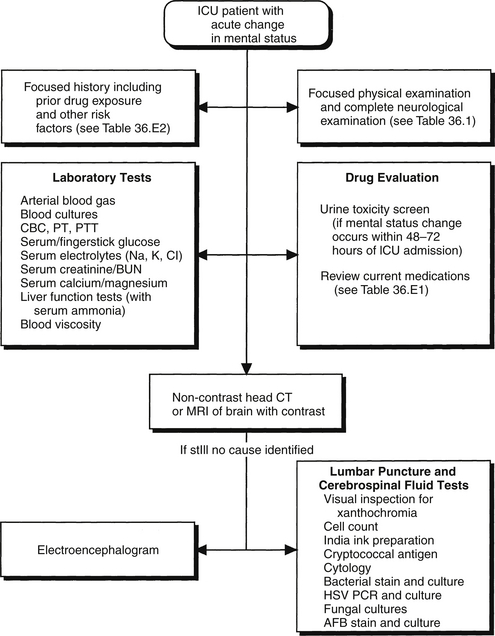Chapter 36
Change in Mental Status 
Definition
Altered mental status (also referred to as “a change in mental status [MS]” or “delta MS”) is a vague but commonly used term that is applied to both alterations in level of consciousness and alterations in cognitive function (cognition, attention, awareness). Level of consciousness can be quickly characterized according to the AVPU scale (Box 36.1). This simplification of the Glasgow Coma Scale is easy to remember and document. Additionally, the ordered continuum allows for tracking of changes in level of consciousness, whereas nonspecific terms such as stuporous or lethargic do not conform to a clear hierarchy. After establishing level of consciousness, cognitive function is assessed to further detail the nature of the disturbance. A commonly used alternative scale to follow level of sedation and agitation in ICU patients is the Richmond Agitation-Sedation Scale or RASS (which is described in more detail in Chapters 5 and 37).
Changes in mental status can arise by two mechanisms: (1) disruption of function in the brain stem reticular activating system or, more commonly, (2) through processes affecting both cerebral hemispheres. Severe dysfunction produces coma, defined as an unresponsive and unarousable state. Less severe dysfunction produces an acute confusional state in which the patient may be sleepy, disoriented, or inattentive but responds to some stimuli in a purposeful manner. The term delirium is more specific than just being confused or disoriented. Delirium is defined as an acute change or fluctuation in mental status combined with inattention and either an altered level of consciousness or disorganized thinking. Delirium is common in ICU patients, with an incidence of 50% or higher (see Chapter 37 for details about diagnosis and management of delirium).
An acute change in mental status is distinct from dementia, aphasia, or psychiatric decompensation. An acute confusional state lasts for hours to days; in contrast, dementia has a much longer time course and is associated with fewer fluctuations in attention and perception. Aphasia can be detected by careful examination of language function. Psychiatric conditions that can mimic an acute confusional state include schizophrenia, depression, mania, autism, and dissociative states. Seizures can also produce a confusional state during the period of actual epileptic discharge or for minutes to hours during the immediate postictal period. Because details of a patient’s baseline and medical history may not be immediately available, however, it is useful to consider dementia, aphasia, and psychiatric decompensation in the initial approach to mental status change.
Causes of Mental Status Change
Causes of changes in mental status are numerous (Table 36.1). Indeed, almost any severe medical or surgical illness may cause delirium in a patient in the ICU, and many such patients have more than one risk factor (Box 36.2). In younger patients, drug abuse and alcohol withdrawal are the most common causes; in contrast, in the elderly, metabolic disturbances, infection (especially associated with severe sepsis), stroke, and iatrogenic drug effects predominate.
TABLE 36.1
Signs and Symptoms Helpful in Determining Change in Mental Status
| Sign/Symptom | Association |
| Asterixis | Metabolic encephalopathy |
| Ataxia | Ethanol or sedative intoxication, Wernicke encephalopathy |
| Bradycardia | Hypothyroidism, cholinergic drug, digoxin toxicity |
| Constricted pupils | Opioid intoxication, pontine stroke |
| Dilated pupils | Head trauma, anticholinergic or sympathomimetic drug intoxication, ethanol or sedative withdrawal, postictal state, brain death, status/post iatrogenic pupillary dilatation |
| Fever | Infection, anticholinergic drug intoxication, ethanol withdrawal, neuroleptic malignant and serotonin syndromes, malignant hyperthermia |
| Headache or meningismus | Meningitis, subarachnoid hemorrhage |
| Hypertension | Hypertensive encephalopathy, anticholinergic or sympathomimetic drug intoxication, ethanol or sedative withdrawal |
| Hyperventilation | Central neurogenic hyperventilation, hepatic encephalopathy, hyperglycemia with diabetic ketoacidosis, sepsis, metabolic acidosis |
| Hypothermia | Sedative intoxication, hepatic encephalopathy, hypoglycemia, hypothyroidism, sepsis, uremia, adrenal insufficiency |
| Hypoventilation | Sedative or opioid intoxication |
| Nystagmus or ophthalmoplegia | Ethanol or sedative intoxication, Wernicke encephalopathy, vertebrobasilar ischemia, phenytoin |
| Papilledema | Hypertensive encephalopathy, intracranial mass, acute hydrocephalus |
| Rigidity | Neuroleptic malignant and serotonin syndromes, opioid reaction, dystonic reaction, hypocalcemia |
| Seizures | Ethanol or sedative withdrawal, theophylline toxicity, hypoglycemia, severe alkalosis |
| Tachycardia | Anticholinergic or sympathomimetic drug intoxication, ethanol or sedative withdrawal |
| Tremor | Sympathomimetic drug intoxication, ethanol or sedative withdrawal, thyrotoxicosis |
There is no single consensus categorization of the many and varied causes of change in mental status. The following five categories of etiologies form the basis for the systematic approach (Figure 36.1): (1) vital sign abnormalities; (2) infection; (3) vascular or structural central nervous system (CNS) abnormalities; (4) toxins, metabolic, and environmental factors; and (5) miscellaneous causes.
Vital Sign Abnormalities
Virtually any vital sign abnormality may be associated with changes in mental status and in some cases may point to a singular cause. Brady- and tachyarrhythmias, hypo- and hypertension, hypoventilation, and oxygen desaturation all may worsen mental status and, if so, demand urgent intervention. An elevated respiratory rate may suggest any number of abnormalities, such as salicylate overdose, stroke, intracranial hemorrhage, early sepsis, severe pain or anxiety, or respiratory compensation for a metabolic acidosis. Hypothermia or hyperthermia may herald sepsis, indicate a thyroid abnormality, or, in the case of fever, suggest a drug or toxin reaction such as serotonin syndrome, neuroleptic malignant syndrome, or alcohol withdrawal (Chapters 31 and 57).

Full access? Get Clinical Tree




